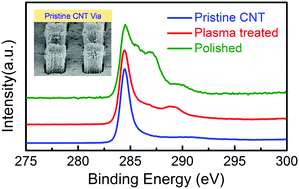当前位置:
X-MOL 学术
›
J. Mater. Chem. C
›
论文详情
Our official English website, www.x-mol.net, welcomes your
feedback! (Note: you will need to create a separate account there.)
Contact resistance reduction of carbon nanotube via through O2 plasma post-synthesis treatment
Journal of Materials Chemistry C ( IF 5.7 ) Pub Date : 2018-04-19 00:00:00 , DOI: 10.1039/c8tc00770e Suwen Li 1, 2, 3, 4 , Yanghui Liu 1, 2, 3, 4 , Shaolin Zhou 5, 6, 7, 8 , Changjian Zhou 5, 6, 7, 8 , Mansun Chan 1, 2, 3, 4
Journal of Materials Chemistry C ( IF 5.7 ) Pub Date : 2018-04-19 00:00:00 , DOI: 10.1039/c8tc00770e Suwen Li 1, 2, 3, 4 , Yanghui Liu 1, 2, 3, 4 , Shaolin Zhou 5, 6, 7, 8 , Changjian Zhou 5, 6, 7, 8 , Mansun Chan 1, 2, 3, 4
Affiliation

|
The cause of high contact resistance between carbon nanotube (CNT) filled vias and metal electrodes is studied. Contamination due to the chemical–mechanical polishing (CMP) process, which damages the sp2 bonds at the end of the CNTs, is found to be the main cause. An alternative oxygen plasma etching process is proposed to preserve the sp2 bonds at the CNT tips during the via planarization process. The improved properties of the CNT tips, with more sp2 bonds and fewer oxygen-containing groups, have been demonstrated using X-ray photoelectron spectroscopy (XPS). Based on the findings, a new CNT via integration process is designed, which includes selective CNT growth inside the via and O2 plasma planarization. A low contact resistance of 1.83 μΩ cm2 is demonstrated.
中文翻译:

通过O 2等离子体后合成处理 降低碳纳米管的接触电阻
研究了填充碳纳米管(CNT)的通孔与金属电极之间高接触电阻的原因。人们发现,化学-机械抛光(CMP)工艺造成的污染是造成碳纳米管末端sp 2键损坏的主要原因。提出了另一种氧等离子体刻蚀工艺,以在通孔平面化工艺期间保留CNT尖端的sp 2键。使用X射线光电子能谱(XPS)证明了具有更多sp 2键和更少含氧基团的CNT尖端的性能得到改善。基于这些发现,设计了一种新的CNT通孔集成工艺,该工艺包括在通孔和O 2内部选择性生长CNT。等离子体平面化。证明了1.83μΩcm 2的低接触电阻。
更新日期:2018-04-19
中文翻译:

通过O 2等离子体后合成处理 降低碳纳米管的接触电阻
研究了填充碳纳米管(CNT)的通孔与金属电极之间高接触电阻的原因。人们发现,化学-机械抛光(CMP)工艺造成的污染是造成碳纳米管末端sp 2键损坏的主要原因。提出了另一种氧等离子体刻蚀工艺,以在通孔平面化工艺期间保留CNT尖端的sp 2键。使用X射线光电子能谱(XPS)证明了具有更多sp 2键和更少含氧基团的CNT尖端的性能得到改善。基于这些发现,设计了一种新的CNT通孔集成工艺,该工艺包括在通孔和O 2内部选择性生长CNT。等离子体平面化。证明了1.83μΩcm 2的低接触电阻。











































 京公网安备 11010802027423号
京公网安备 11010802027423号